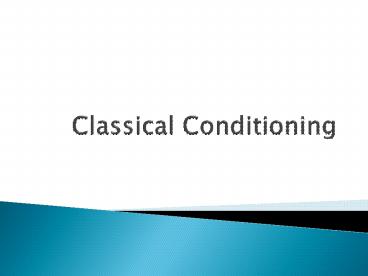Classical Conditioning - PowerPoint PPT Presentation
1 / 16
Title:
Classical Conditioning
Description:
Classical Conditioning The type of learning in which a stimulus acquires the capacity to evoke the response initially evoked by another stimulus an item creates a ... – PowerPoint PPT presentation
Number of Views:295
Avg rating:3.0/5.0
Title: Classical Conditioning
1
Classical Conditioning
2
Background
- Classical Conditioning The type of learning in
which a stimulus acquires the capacity to evoke
the response initially evoked by another stimulus - an item creates a response it wouldnt normally
cause through pairing - Introduction Clip
- http//www.youtube.com/watch?vznAzMkn5Ey0
3
Pavlovs Discovery of Classical Conditioning
- Ivan Pavlov
- Conducted research on digestion, specifically
role of saliva in digestion process of dogs. - Pavlov presented meat (powder) to dogs, preceded
by a clicking sound to alert them of the food. - Over time, dogs salivated in response to clicking
sound.
4
- Pavlov further investigated phenomenon
- Presented meat with a tone (bell)
- After several pairings, he presented bell alone
to dogs - What happened?
- What is the significance of his research?
5
Classical Conditioning Terminology
- 1.) Unconditioned Stimulus (US)- The stimulus
that evokes a natural response. - Pavlov Ex.)
- 2.) Unconditioned Response (UR)- The natural
reaction to the unconditioned stimulus. - Pavlov Ex.)
6
Classical Conditioning Terminology
- 3.) Conditioned Stimulus (CS)- Previously neutral
stimulus that, through conditioning, evokes
conditioned response. - Pavlov Ex.)
- 4.) Conditioned Response (CR)- Learned reaction
to conditioned stimulus that occurs because of
previous conditioning - Usually the same as UR
- Pavlov Ex.)
7
Process Review
8
Trials
- Trials- Presentations of the stimuli (US and CS)
together - Pavlov Ex.)
- The Office Ex.)
- Number of trials needed for classical
conditioning to occur varies
9
More examples
- The Office
- US-
- UR-
- CS-
- CR-
10
More Examples
- Shower Example
- US-
- UR-
- CS-
- CR-
11
Conditioned Fear and Anxiety
- Many of our phobias and fears are direct result
of classical conditioning - Examples
- Bridge Phobia
- Taco Bell
- Class Examples
12
Other Conditioned Responses
- May be conditioned to associate stimulus with
positive feelings - Examples
- Cotton candy ice cream
- Classical conditioning could even play a role in
sexual arousal - Example
- Seinfeld clip
- http//www.youtube.com/watch?vvLKhJnKrf9M
13
Processes in classical conditioning
- 1.) Acquisition- This term refers to the learning
of the conditioned response - 2.) Extinction This refers to a gradual
weakening and disappearance of conditioned
response - How does this usually occur?
14
Processes in classical conditioning
- 3.) Spontaneous Recovery- After extinction, a
response may spontaneously reappear. - Real World Examples
15
Stimulus Generalization
- Stimulus Generalization An organism that has
learned a response to a specific stimuli responds
in same way to stimuli that are similar to
original stimulus. - Clown Example
- John B. Watson study
- Little Albert- 11 month old
- Conditioned to fear bunnies
16
- Class examples, if time permits































